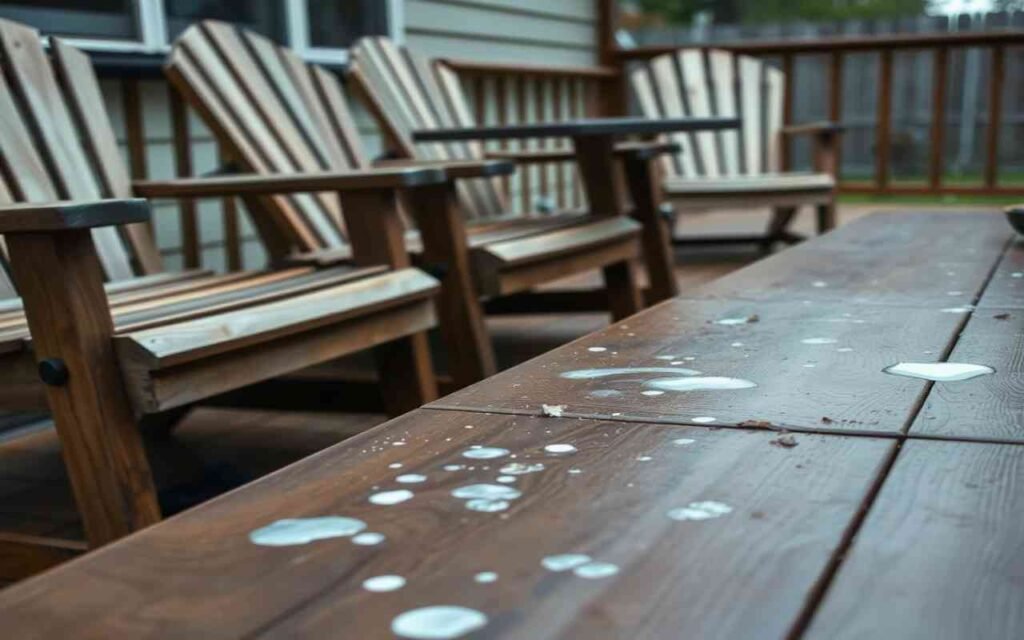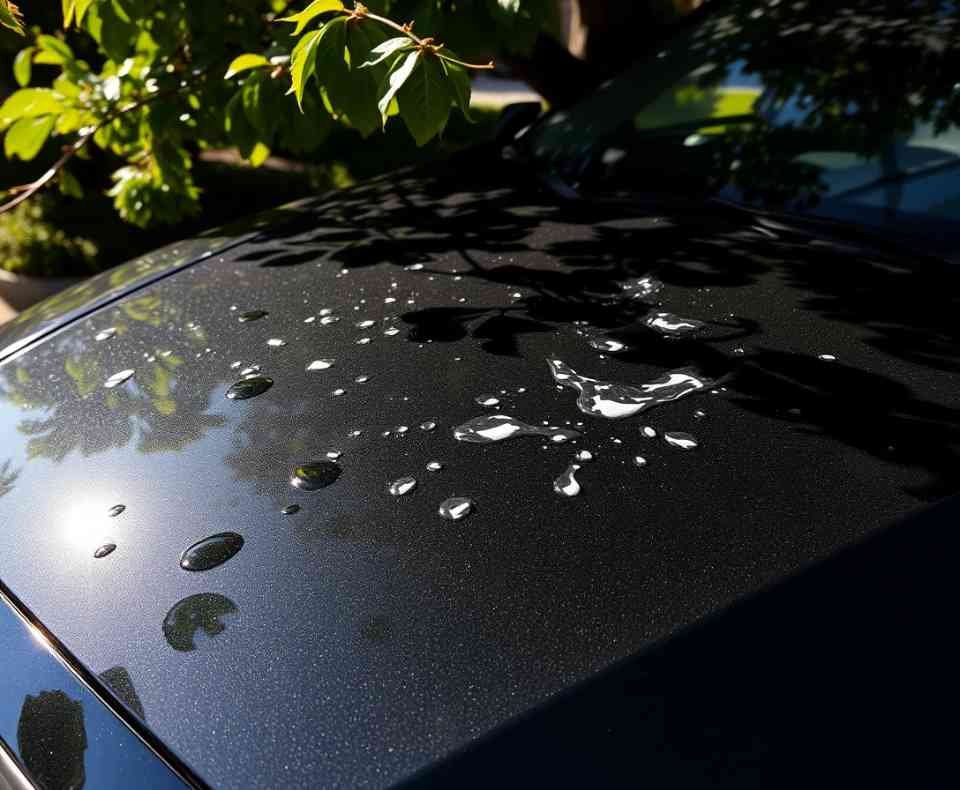You step out onto your deck with your morning coffee, ready to enjoy a peaceful moment, and BAM. Your favorite outdoor chair looks like it hosted a pigeon convention overnight. Welcome to the glamorous world of how to clean up bird droppings, where Mother Nature’s little gifts keep showing up uninvited.
I’ve been battling this exact scenario for years at my place. Between the cardinals who think my car is their personal bathroom and the sparrows who’ve apparently designated my patio furniture as ground zero for their digestive activities, I’ve become something of an expert in cleaning bird poop from every imaginable surface.
Here’s the thing: bird droppings removal isn’t just about aesthetics. These acidic little packages can permanently damage paint, metal, and fabric if you don’t handle them properly. Plus, nobody wants to explain to dinner guests why there’s a Jackson Pollock interpretation decorating their outdoor furniture.
Quick TL;DR: Bird Droppings Cleanup
- Protect yourself: Gloves, mask, and eye protection.
- Remove solids gently: Plastic scraper or putty knife, outside edges first.
- Rinse immediately: Use cool water to dilute acids.
- Surface-specific care: Use vinegar, baking soda, or enzyme cleaners depending on material.
- Prevent repeat messes: Wax surfaces, use barriers, and maintain regular cleaning.
Understanding What You’re Actually Dealing With
Let’s talk about bird waste composition because knowing your enemy helps you fight it better. Bird droppings aren’t just random gross stuff; they’re a complex mixture that requires specific cleanup strategies.
Uric acid makes up the white portion of bird droppings, and it’s the real troublemaker here. This stuff is incredibly corrosive and can etch into surfaces permanently if left sitting too long.
A study published in ScienceDirect found that uric acid in bird droppings contributes to the deterioration of stone and concrete surfaces. From my own experience, even on a car hood, letting droppings sit for a week can lead to some nasty etching.
The dark portions contain digested food matter, bacteria, and other organic compounds. These components can stain surfaces and create odors that attract more birds to the same spots. Basically, one bird’s bathroom break becomes an invitation for the whole flock. For help identifying what type of bird made the mess, check out our detailed bird dropping identification guide.
Fresh droppings clean up much easier than dried, crusty deposits that have baked in the sun for days. The longer you wait, the more challenging your cleanup becomes. Trust me on this one.
Safety First: Protecting Yourself During Cleanup
Before you grab that paper towel and start scrubbing, let’s chat about bird dropping safety precautions. This isn’t just about being squeamish; there are legitimate health concerns here.
Disease transmission through bird droppings is real. We’re talking about potential exposure to salmonella, E. coli, and histoplasmosis, among other unpleasant possibilities. These microorganisms don’t care how tough you think you are.
Personal protective equipment becomes essential for any serious cleanup job. Rubber gloves protect your hands from direct contact and prevent bacteria from getting under your fingernails. Disposable gloves work great for small jobs, but invest in heavy-duty rubber gloves for larger cleanups.
Respiratory protection matters more than most people realize. Dried bird droppings become airborne easily when disturbed, and inhaling that dust can cause respiratory problems. A simple dust mask provides adequate protection for most situations.
Eye protection prevents accidental splashing during cleanup. I once got overzealous with a pressure washer and learned this lesson the hard way. Safety glasses take seconds to put on and prevent potentially serious complications.
Immediate Response: Fresh Dropping Cleanup
Caught the crime in progress or discovered fresh bird droppings on your property? Quick action makes cleanup exponentially easier and prevents permanent damage.
Act fast with fresh droppings because they haven’t had time to bond with surfaces or dry into concrete-like deposits. The first 30 minutes after deposition represent your best cleanup window.
Scrape gently using a plastic putty knife or similar tool to remove as much solid matter as possible. Avoid metal scrapers that might scratch delicate surfaces. Work from the outside edges toward the center to prevent spreading.
Rinse immediately with cool water to dilute remaining acids and prevent etching. Hot water actually sets protein stains, so stick with cool or lukewarm temperatures. This initial rinse removes the immediate threat to your surfaces.
Avoid rubbing fresh droppings into surfaces. Blotting and gentle scraping work much better than aggressive scrubbing, which just grinds the mess deeper into porous materials.
Surface-Specific Cleaning Strategies
Different materials require different approaches for effective bird dropping removal. What works on concrete might destroy fabric, so let’s break this down by surface type.
Cleaning Bird Droppings from Cars
Automotive paint needs gentle treatment because bird droppings can permanently etch clear coat if handled improperly. Start with cool water rinse to soften dried deposits. To prevent repeat offenses, consider strategies to keep birds off your car after cleanup.
Clay bar treatment works fantastically for stubborn spots that won’t rinse away. Automotive clay safely removes embedded contaminants without scratching paint, and following up with a good wax will restore protection.
Glass surfaces handle more aggressive cleaning, but avoid ammonia-based cleaners that can damage tinted windows. A mixture of white vinegar and water works great for windshields and side windows.
Chrome and metal trim can tolerate stronger cleaners, but acidic droppings may have already started corrosion. Use dedicated metal polish to restore shine after cleaning.
Outdoor Furniture and Decking
Fabric cushions require immediate attention to prevent permanent staining. Remove solid matter first, then treat with enzyme cleaners designed for protein stains. Machine wash if possible, following manufacturer instructions.
Wooden surfaces need gentle cleaning to avoid damage to finishes. A mixture of dish soap and warm water handles most cleanup jobs without stripping protective coatings.
Metal furniture tolerates stronger cleaners but check for paint damage before applying aggressive solutions. Pressure washing works well for heavily soiled pieces.
Composite decking cleans easily with soap and water for fresh droppings. Dried deposits might need gentle scrubbing with a soft brush to avoid surface scratching.
Homemade Cleaning Solutions That Actually Work
Why spend a fortune on specialized bird dropping cleaners when your kitchen cabinet contains everything you need for effective cleanup?
White vinegar solution cuts through uric acid deposits like a champ. Mix equal parts white vinegar and warm water for most cleaning jobs. The acetic acid neutralizes alkaline bird droppings while disinfecting surfaces.
Baking soda paste handles stubborn stains and odors naturally. Mix baking soda with just enough water to create a thick paste, apply to stains, let sit for 15 minutes, then scrub gently with a soft brush.
Dish soap mixture works great for fresh droppings on most surfaces. Use two tablespoons of liquid dish soap per quart of warm water. The surfactants break down organic matter while being gentle on surfaces.
Enzyme cleaners excel at breaking down protein-based stains and odors. According to Bird Barrier, certain enzymatic cleaning products help decompose droppings effectively. You can buy commercial versions or make your own using pineapple juice (contains natural enzymes) mixed with warm water.
Commercial Cleaning Products: When DIY Isn’t Enough
Sometimes professional bird dropping removers offer advantages over homemade solutions, especially for large-scale cleanup jobs or delicate surfaces.
Specialized bird dropping cleaners contain enzymes and surfactants specifically formulated for this type of mess. They work faster than DIY solutions and often provide better results on stubborn stains.
Pressure washer additives help break down organic matter before high-pressure rinsing. These products prevent you from needing excessive pressure that might damage surfaces.
Disinfecting cleaners kill bacteria and viruses while cleaning, providing extra peace of mind for areas where children or pets spend time.
IMO, the best commercial products combine cleaning power with disinfection in a single step. Look for products specifically labeled for bird dropping cleanup rather than generic all-purpose cleaners.
Tools and Equipment for Effective Cleanup
Having the right bird dropping cleanup tools makes the job faster, easier, and more thorough. You don’t need a garage full of equipment, but a few key items make all the difference.
Plastic scrapers remove solid matter without scratching surfaces. Keep several sizes on hand for different cleanup jobs. Old credit cards work perfectly for small spots.
Soft-bristled brushes help work cleaning solutions into textured surfaces without causing damage. Natural bristles work better than synthetic for delicate materials.
Spray bottles provide controlled application of cleaning solutions. Adjustable nozzles let you switch between fine mist and direct stream depending on your needs.
Microfiber cloths absorb more liquid and trap particles better than paper towels or cotton rags. They’re also reusable and more environmentally friendly.
Preventing Permanent Stains and Surface Damage
Bird dropping stain prevention starts with understanding how these acidic deposits interact with different materials over time.
Time is your enemy when it comes to preventing permanent damage. Uric acid continues eating into surfaces as long as it remains in contact. Even if you can’t do a complete cleanup immediately, at least rinse the area with water.
pH neutralization stops acid damage in its tracks. A quick sprinkle of baking soda over fresh droppings neutralizes acid immediately, buying you time for proper cleanup later.
Surface protection through regular waxing or sealing creates barriers that prevent droppings from bonding directly with underlying materials. Car wax works great on outdoor furniture too.
Regular maintenance prevents small problems from becoming big ones. Weekly inspection and cleanup of favorite bird perching spots keeps accumulation manageable.
Tackling Large-Scale Cleanup Projects
Sometimes you’re not dealing with a few scattered droppings but rather a full-scale bird infestation cleanup. These jobs require different strategies and more serious safety precautions.
Wet down areas before starting cleanup to prevent dust clouds that spread bacteria and make cleanup harder. A garden hose with spray attachment works perfectly for this.
Work systematically from top to bottom, cleaning highest surfaces first so debris doesn’t fall on already-cleaned areas. This approach prevents having to redo work.
Dispose of waste properly by bagging all cleanup materials and disposing in regular trash. Don’t compost bird droppings or rinse large amounts down storm drains.
Consider professional help for extensive contamination, especially in enclosed spaces like attics or garages where ventilation is limited and contamination levels might be high.
Cleaning Different Types of Bird Droppings
Not all bird waste looks or behaves the same way. Different bird species produce different types of droppings that require adjusted cleanup strategies.
Pigeon droppings tend to be larger and more acidic than smaller songbird waste. They also accumulate in greater quantities since pigeons roost in flocks. These require more aggressive cleaning solutions.
Seagull mess is particularly nasty because of their varied diet and large size. Coastal property owners know this struggle well. These droppings often contain partially digested food that attracts insects.
Small songbird droppings clean up easily when fresh but can be surprisingly stubborn when dried. Their small size means they often get overlooked until accumulation becomes noticeable.
Waterfowl waste tends to be more liquid and spreads over larger areas. Duck and geese droppings require different cleanup approaches than typical perching bird waste.
Health Considerations and When to Call Professionals
FYI, some bird dropping cleanup situations require professional intervention rather than DIY approaches.
Extensive accumulation in enclosed spaces like attics, barns, or storage sheds creates health hazards that exceed safe DIY cleanup levels. Professional remediation companies have proper equipment and training.
Immunocompromised individuals should avoid bird dropping cleanup entirely. According to Skedaddle Wildlife, people with weakened immune systems are at higher risk of serious infections from pathogens in bird droppings. Pregnant women, elderly individuals, or anyone with respiratory conditions face elevated risks from airborne contaminants.
Historical accumulation that’s been building for months or years requires hazmat-level precautions. These situations often involve fungal growth and concentrated bacterial contamination.
Recurring infestations might indicate structural problems that need professional assessment. Sometimes bird dropping problems stem from larger pest control issues.
Seasonal Considerations for Cleanup
Bird activity patterns vary throughout the year, affecting when and how often you’ll need to deal with cleanup challenges.
Spring nesting season brings increased bird activity and territorial behavior. Expect more droppings near nesting sites as parent birds spend more time in specific areas.
Summer molting periods can increase dropping volume as birds process higher food volumes to support feather regrowth. This is peak cleanup season for most regions. During summer heat, birds need extra care, see how to keep birds hydrated during summer to reduce mess and stress.
Fall migration creates temporary but intensive dropping problems as migrating flocks stop to rest and feed. Coastal and waterway properties see the biggest impact.
Winter feeding concentrates birds around food sources, leading to heavy accumulation in specific areas. This season also presents cleanup challenges due to freezing and thawing cycles. Plan ahead with tips for feeding birds in winter to minimize droppings and keep birds healthy.
Long-Term Prevention Strategies
The best bird dropping management strategy combines effective cleanup with measures that discourage birds from choosing your property as their bathroom.
Habitat modification makes your property less attractive to problem species without harming beneficial birds. Remove food sources, nesting opportunities, and perching sites in problem areas.
Physical barriers like netting, spikes, or wire systems prevent birds from accessing favorite roosting spots. These solutions work better than trying to clean up after established flocks.
Regular maintenance routines prevent small problems from becoming major headaches. Weekly inspection and spot cleaning take minutes but save hours of intensive cleanup later.
Your relationship with bird droppings doesn’t have to be adversarial. With the right knowledge, tools, and approach, you can maintain a clean property while coexisting peacefully with your feathered neighbors.
I still get dive-bombed by that cardinal family every spring :/ But now I’m prepared with my arsenal of cleaning supplies and strategies. The key is staying ahead of the mess rather than letting it accumulate into overwhelming cleanup projects.
Remember, every bird dropping you clean promptly is one less permanent stain you’ll have to explain to visitors. Trust me, your future self will thank you for taking action today rather than hoping the rain will handle it for you.



